Starting A Pollinator Garden
Plant a new pollinator garden! When planning, consider the best light, soil, and water to accommodate our beautiful pollinating friends.


Our 5-part master video course on Creating A Butterfly Garden is inspiring gardeners everywhere to re-think how they plan their gardens.
As we explore what it means to be a steward for butterflies, bees and other pollinators, it’s important to understand how to plan for and design a pollinator garden that provides the most value for these important creatures. Planting a pollinator garden is a fantastic way of supporting pollinator populations, especially those in decline like our precious bees and monarch butterflies.
How To Start A Bee And Butterfly Garden
Before we can hope to feed them, we need to plan the perfect ways to invite pollinators to our yards, gardens and other growing spaces in such a way that they can readily recognize a food source. Just a hint: Pollinators are attracted to colorful, bright flowers that they know contain the nectar they need.
When considering designing your garden for pollinators you’ll need to learn which local plants are native to your region, note your sun conditions and consider your soil and water sources. It may sound daunting, but as you’ll see in our butterfly course, it’s not difficult to create a valuable fueling station for migrating monarchs and a flourishing stopover for our beneficial pollinators.
The success of a pollinator garden means one thing: you will attract pollinators of all kinds to your garden simply by correctly planting the right flowers at the right time in the right place. The beautiful pollinator garden featured in this video is located in Pennsylvania and is well known for its beauty and the number of monarchs it feeds every year.
Why Create a Garden for Pollinators?
Establishing an outdoor space that supports bees, butterflies and other pollinators is fairly simple, but hugely important. You may even want to re-think your existing garden to incorporate plants for pollinators. Here are just a few of the benefits:
- Supporting pollinators -- The USDA says “Three-fourths of the world's flowering plants and about 35 percent of the world's food crops depend on (…) pollinators to reproduce." That's one out of every three bites of food you eat. Pollinators are essential to our ecosystems and food production. But, due to the use of chemicals and the loss of proper habitats, some of their species are in serious decline. You can do your part to support them by providing a suitable environment.
- Assisting all wildlife -- The best pollinator gardens are often profuse with native plants. Native plants benefit all local wildlife, in addition to offering some of the best food for pollinators.
- Growing fruits and veggies -- Pollinators in your garden unquestionably increase your yield of produce and fruits. Almost anything you choose to grow will benefit from pollinators of all kinds.
- Using less water -- Consider replacing turf lawn with pollinator-friendly and native plants. They use less water, and the benefits are plentiful.
How to Get Started with a Pollinator or Butterfly Garden
Whether you’re interested in attracting all types of pollinators or specifically want to invite beautiful butterflies, the steps to starting a garden are the same:
Gardening tips, videos, info and more delivered right to your inbox!
Sign up for the Gardening Know How newsletter today and receive a free download of our DIY eBook "Bring Your Garden Indoors: 13 DIY Projects For Fall And Winter".
Choose Pollinator-Friendly Native Species
Most importantly, your garden needs plants that pollinators crave and will thrive on. Nectar-heavy flowers make the best pollinator food. Check with your local extension office for advice on the best pollinator plants for your specific area. Natives are best, but some non-native species that are not invasive may also be useful in a pollinator setting.
Plant According to Sunlight
You need to choose the appropriate plants, not just for pollinators, but for your yard’s available light. Take a picture of the area you want to plant at 9:00 in the morning, at noon, and at 3:00 in the afternoon to see which areas have full sun (at least six hours per day), partial sun or mostly shade.
Having this information will help you select and position your plants for the best outcome. Most pollinator plants prefer full sun, but you can find species that tolerate or even thrive in some shade. Butterflies and other insects will appreciate a shady resting spot, so aim for a garden with mostly sun and a little shade.
Check the Soil
Native plants should already be adapted to your soil, but there will be exceptions. Your property’s soil might have some issues that should be corrected to best support your plants. The best way to know is to do a soil test. You can find soil testing kits at your local garden center. Alternatively, contact your local extension office for a soil testing kit, which you can send in for expert results and recommendations.
Water as Needed
Again, native plants are already adapted to the amount of rainfall in your area. This makes gardening with native species resource-efficient and low-maintenance. However, even natives are likely to need some help as they get established in your garden. Be prepared to water your garden regularly for the first couple of years and whenever you have drought conditions.
To learn more great tips on how to create a beautiful pollinator garden, check out our colorful and informative course, Creating a Butterfly Garden. We promise you will learn everything you need to entice, feed, and help pollinators year after year. Our online course includes details about plant selection, soil preparation, garden design and supporting our all-important migrating monarchs.

Heather Andrews is a published author, an astute photographer, and an avid expert gardener. She spends much of her time helping people create sustainable gardens as a way to attract wildlife, support pollinators and increase vegetable yield using native plants.
